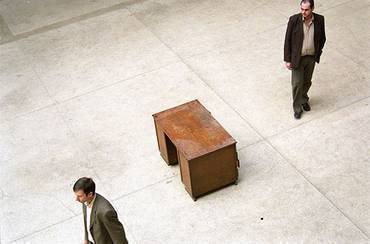That, what is not said
dal 14/2/2012 al 15/3/2012
Segnalato da
Kaya Behkalam
Erik Buenger
Sven Johne
Claudia Larcher
Elke Marhoefer
Barbara Musil
Veronika Schubert
Gregg Smith
Sabine Winkler
14/2/2012
That, what is not said
Ratskeller Gallery, Berlin
Subtexts in Politics and Art. The presented works analyse codifications within psychological, ideological and artistic systems. They deal with these different underlying semantic levels of subtexts, asking for its possible operation purpose, intentions, codifications, representations and authors' positions: Who talks to whom? What is said, what is not said, and why not? What can be said, or should not be said, which images are constructed, which ideologies affirmed and which contents are suppressed?

curated by Sabine Winkler
Kaya Behkalam, Erik Bünger, Sven Johne, Claudia Larcher, Elke Marhöfer, Barbara Musil, Veronika Schubert, Gregg Smith
The exhibition 'THAT, what is not said – Subtexts in Politics and Art' deals with different semantic levels of the unsaid within political and artistic systems. Which different forms of subtexts do exist and how are they used in culture and politics. The presented works analyse codifications within psychological, ideological and artistic systems. To whom subtexts are addressed and whom do they exclude? Is it a matter of implied presettings of patterns of thoughts and behaviour, or do subtexts represent the unconscious, traumata, blank-spaces, secrets and so on? The artworks deal with these different underlying semantic levels of subtexts, asking for its possible operation purpose, intentions, codifications, representations and authors' positions: Who talks to whom?' What is said, what is not said, and why not? What can be said, or should not be said, which images are constructed, which ideologies affirmed and which contents are suppressed? The exhibition focuses on those, not at first glance visible secretive narratives and contents.
Kaya Behkalam revises George Bataille's text 'Un-knowing and Its Consequences', referring to his theory of Unknowing. Negations are the only passages in the revised text that are not blurred with black colour, marking the rest of the text as unknowing. Two different ideologic narratives of the the same catastrophe, the sinking of the Titanic, encounter in Erik Bünger's video 'God moves on the water', exploring different presentation forms of the unsaid. In his video 'Elmenhorst' Sven Johne refers to the unsaid and its relation to personal memories and history. Claudia Larcher uses the unsaid as a dramaturgic and suspense raising means, producing insecurity, uncertainty, fear etc. Elke Marhöfer explores methods of censorship, relating to the demonstrations against the Algerian War on 17th October 1961 in Paris. The publication of the genuine number of the persons that were killed by the police was prevented by the French government. Barbara Musil analysis atmospheres of the financial market in Estonia, exploring the unsaid within melancholic systems. Veronika Schubert shows in her found-footage animation a montage of stereotypical expressions and latitudes of the inspectors in the German crime series 'Tatort'. The search for the murderer represents the search for the unsaid, for that, what is concealed. Gregg Smith stages the unsaid as a conflict, that cannot be resolved on a linguistic level, but is communicated through certain ways of behaving, gestures, glances etc.
Events:
22.02.2012, 7 pm
Es fiel ein Schuss in Sarajevo
Play reading: Lore Seichter-Muráth
29.02.2012, 7 pm
Context and Subtext: Artists discuss their methods of production
Miro Kaygalak and Katharina Kummer:
errorist - you are right if you are wrong
Moderation Katja Jedermann and Ute Müller-Tischler
in cooperation with the Institute for Art in Context,
Berlin University of the Arts, Department of Fine Arts
Image: Gregg Smith, The End, 2006
Opening: February 15, 2012, 7 pm
Ratskeller Gallery
Möllendorffstr. 6, 10367 Berlin
Gallery Hours: Monday – Friday 10.00am – 6.00pm
admission free



